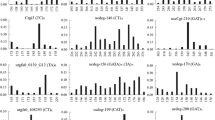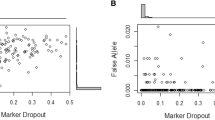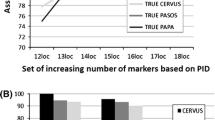Abstract
Pedigrees have a long history in classical genetics, agronomics, evolutionary ecology, and ex situ captive breeding. Use of molecular techniques has expanded the variety of species for which pedigrees can be constructed. However, molecular pedigrees almost exclusively consider microsatellite loci, despite advances in high-throughput sequencing allowing development of genomic marker sets in nearly any organism. Here we generate a novel set of genomic SNPs derived from ddRAD sequencing in two populations of Weddell seals (Leptonychotes weddellii) and describe the diversity and differentiation between them. We then compare and contrast parentage assignment rates and accuracy in one population that has been the subject of long-term monitoring. Specifically, we consider pedigrees constructed using two sets of markers (microsatellites and SNPs), two pedigree construction software (CERVUS than Sequoia), as well as varying the groupings of candidate parents (either all individuals simultaneously, only individuals born before a focal year, or only individuals known to have survived to a focal year). ddRAD sequencing returned between 1568 and 3240 loci depending on whether both populations were considered simultaneously or individually. Parentage assignment rates were always higher using CERVUS than Sequoia, with the latter at times either not assigning parentage or creating “inferred parents”. In all cases, “polarizing” the datasets (e.g., including year of birth) significantly improved assignments. This represents one of the first direct comparisons of pedigree construction using different markers in the same set of individuals, and the SNPs described here will be a resource for continued pedigree construction, and future research in Weddell seals.

adapted from: Polar Geospatial Center, 2018, “PGC Map Catalog”, https://doi.org/10.7910/DVN/6R8F7U, Harvard Dataverse, V1, Map 16: Victoria Land, August 16, 2021. The inset Antarctic map was obtained from: NOAA National Centers for Environmental Information (NCEI); International Bathymetric Chart of the Southern Ocean (IBCSO); General Bathymetric Chart of the Oceans (GEBCO)

Similar content being viewed by others

Data Availability
Sequencing reads are archived on NCBI (Accessions: SAMN19069034-SAMN19069205). VCF files for whole dataset as well as each of the 10 random subsets are included as supplementary materials.
Code availability
Not applicable.
References
Allendorf F (1993) Delay of adaptation to captive breeding by equalizing family size. Conserv Biol 7:416–419
Anderson EC (2012) Large-scale parentage inference with SNPs: an efficient algorithm for statistical confidence of parent pair allocations. Statistical Applications in Genetics and Molecular Biology. https://doi.org/10.1515/1544-6115.1833
Anderson EC, Garza JC (2006) The power of single-nucleotide polymorphisms for large-scale parentage inference. Genetics 172:2567–2582
Backström N, Brandstrom M, Gustafsson L et al (2006) Genetic mapping in a natural population of collared flycatchers (Ficedula albicollis): Conserved synteny but gene order rearrangements on the avian Z chromosome. Genetics 174:377–386
Blundell GM, Pendleton GW (2008) Estimating age of harbor seals (Phoca vitulina) with incisor teeth and morphometrics. Mar Mamm Sci 24:577–590
Cabrera AA, Palsbøll PJ (2017) Inferring past demographic changes from contemporary genetic data: A simulation-based evaluation of the ABC methods implemented in diyabc. Mol Ecol Resour 17:e94–e110
Catchen JM, Amores A, Hohenlohe P, Cresko W, Postlethwait JH (2011) <em>Stacks</em>: Building and Genotyping Loci <em>De Novo</em> From Short-Read Sequences. G3: Genes|Genomes|Genetics, 1, 171–182.
Catchen J, Hohenlohe PA, Bassham S, Amores A, Cresko WA (2013) Stacks: an analysis tool set for population genomics. Mol Ecol 22:3124–3140
Charpentier M, Setchell JM, Prugnolle F et al (2005) Genetic diversity and reproductive success in mandrills (Mandrillus sphinx). Proc Natl Acad Sci USA 102:16723–16728
Chen N, Cosgrove EJ, Bowman R, Fitzpatrick JW, Clark AG (2018) Genomic consequences of population decline in the endangered florida scrub-jay. Curr Biol 26:2974–2979
Dakin EE, Avise JC (2004) Microsatellite null alleles in parentage analysis. Heredity 93:504–509
Evans LM, Tahmasbi R, Jones M et al (2018) Narrow-sense heritability estimation of complex traits using identity-by-descent information. Heredity 121:616–630
Farquharson KA, Hogg CJ, Grueber CE (2019) A case for genetic parentage assignment in captive group housing. Conserv Genet 20:1187–1193
Fienieg ES, Galbusera P (2013) The use and integration of molecular DNA information in conservation breeding programmes: a review. Journal of Zoo and Aquarium Research 1:44–51
Flanagan SP, Jones AG (2019) The future of parentage analysis: From microsatellites to SNPs and beyond. Mol Ecol 28:544–567
Geist V (1966) Validity of horn segment counts in aging bighorn sheep. J Wildl Manag 30:634–635
Gelatt TS, Davis CS, Stirling I et al (2010) History and fate of a small isolated population of Weddell seals at White Island, Antarctica. Conserv Genet 11:721–735
Gipson PS, Ballard WB, Nowak RM, Mech LD (2000) Accuracy and precision of estimating age of gray wolves by tooth wear. J Wildl Manag 64:752–758
Guichoux E, Lagache L, Wagner S et al (2011) Current trends in microsatellite genotyping. Mol Ecol Resour 11:591–611
Hadfield JD, Richardson DS, Burke T (2006) Towards unbiased parentage assignment: combining genetic, behavioural and spatial data in a Bayesian framework. Mol Ecol 15:3715–3730
Hemming JE (1969) Cemental deposition, tooth succession, and horn development as criteria of age in dall sheep. J Wildl Manag 33:552–558
Hewison AJM, Vincent JP, Angibault JM et al (1999) Tests of estimation of age from tooth wear on roe deer of known age: variation within and among populations. Can J Zool 77:58–67
Huisman J (2017) Pedigree reconstruction from SNP data: parentage assignment, sibship clustering and beyond. Mol Ecol Resour 17:1009–1024
Huisman J, Kruuk LEB, Ellis PA, Clutton-Brock T, Pemberton JM (2016) Inbreeding depression across the lifespan in a wild mammal population. Proc Natl Acad Sci 113:3585–3590
Jaari S, Li M-H, Merilä J (2009) A first-generation microsatellite-based genetic linkage map of the Siberian jay (Perisoreus infaustus): insights into avian genome evolution. BMC Genomics. https://doi.org/10.1186/1471-2164-10-1
Jiménez-Mena B, Schad K, Hanna N, Lacy RC (2016) Pedigree analysis for the genetic management of group-living species. Ecol Evol 6:3067–3078
Johnson EI, Wolfe JD, Brandt Ryder T, Pyle P (2011) Modifications to a molt-based ageing system proposed by Wolfe et al. (2010). J Field Ornithol 82:422–424
Jones AG, Small CM, Paczolt KA, Ratterman NL (2010) A practical guide to methods of parentage analysis. Mol Ecol Resour 10:6–30
Jones OR, Wang J (2010) Molecular marker-based pedigrees for animal conservation biologists. Anim Conserv 13:26–34
Kalinowski ST, Taper ML, Marshall TC (2007) Revising how the computer program cervus accommodates genotyping error increases success in paternity assignment. Mol Ecol 16:1099–1106
Keller LF (1998) Inbreeding and Its Fitness Effects in an Insular Population of Song Sparrows (Melospiza melodia). Evolution 52:240–250
Kruuk LEB (2004) Estimating genetic parameters in natural populations using the “animal model”. Philosophical Transactions of the Royal Society of London. Series b: Biological Sciences 359:873–890
Leroy G (2011) Genetic diversity, inbreeding and breeding practices in dogs: Results from pedigree analyses. Vet J 189:177–182
Li H, Durbin R (2009) Fast and accurate short read alignment with Burrows-Wheeler transform. Bioinformatics 25:1754–1760
Li H, Durbin R (2010) Fast and accurate long-read alignment with Burrows-Wheeler transform. Bioinformatics 26:589–595
Lynch M, Walsh B (1998) Genetics and analysis of quantitative traits. Sinauer Sunderland MA.
MacDonald ZG, Dupuis JR, Davis CS et al (2020) Gene flow and climate-associated genetic variation in a vagile habitat specialist. Mol Ecol 29:3889–3906
Malenfant RM, Coltman DW, Richardson ES et al (2016) Evidence of adoption, monozygotic twinning, and low inbreeding rates in a large genetic pedigree of polar bears. Polar Biol 39:1455–1465
Malenfant RM, Davis CS, Richardson ES, Lunn NJ, Coltman DW (2018) Heritability of body size in the polar bears of Western Hudson Bay. Mol Ecol Resour 18:854–866
Marshall TC, Slate J, Kruuk LEB, Pemberton JM (1998) Statistical confidence for likelihood-based paternity inference in natural populations. Mol Ecol 7:639–655
Martin M (2011) Cutadapt removes adapter sequences from high-throughput sequencing reads. Embnet.journal 17:10–12
Meirmans PG, Van Tienderen PH (2004) GENOTYPE and GENODIVE: Two programs for the analysis of genetic diversity of asexual organisms. Mol Ecol Notes 4:792–794
Miller EJ, Eldridge MDB, Morris K, Thomas N, Herbert CA (2015) Captive management and the maintenance of genetic diversity in a vulnerable marsupial, the greater bilby. Australian Mammalogy 37:170–181
Mrode RA, Thompson R (2014) Linear models for the prediction of animal breeding values, 3rd Edition. CAB
Mulvihill RS (1993) Using wing molt to age passerines. North American Bird Bander 18:10
Nielsen RK, Pertoldi C, Loeschcke V (2007) Genetic evaluation of the captive breeding program of the Persian wild ass. J Zool 272:349–357
Nietlisbach P, Camenisch G, Bucher T et al (2015) A microsatellite-based linkage map for song sparrows (Melospiza melodia). Mol Ecol Resour 15:1486–1496
Nunziata SO, Weisrock DW (2018) Estimation of contemporary effective population size and population declines using RAD sequence data. Heredity 120:196–207
Paetkau D, Strobeck C (1995) The molecular basis and evolutionary history of a microsatellite null allele in bears. Mol Ecol 4:519–520
Paris JR, Stevens JR, Catchen JM (2017) Lost in parameter space: a road map for stacks. Methods Ecol Evol 8:1360–1373
Paterson JT, Rotella JJ, Link WA, Garrott R (2018) Variation in the vital rates of an Antarctic marine predator: the role of individual heterogeneity. Ecology 99:2385–2396
Patterson N, Price AL, Reich D (2006) Population structure and eigenanalysis. PLoS Genet 2:e190
Pemberton JM (2008) Wild pedigrees: the way forward. Proceedings of the Royal Society b: Biological Sciences 275:613–621
Perrier C, Delahaie B, Charmantier A (2018) Heritability estimates from genomewide relatedness matrices in wild populations: Application to a passerine, using a small sample size. Mol Ecol Resour 18:838–853
Peterson BK, Weber JN, Kay EH, Fisher HS, Hoekstra HE (2012) Double Digest RADseq: An Inexpensive Method for De Novo SNP discovery and genotyping in model and non-model species. PLoS ONE 7:e37135
Piepho HP, Möhring J, Melchinger AE, Büchse A (2008) BLUP for phenotypic selection in plant breeding and variety testing. Euphytica 161:209–228
Poissant J, Davis CS, Malenfant RM, Hogg JT, Coltman DW (2012) QTL mapping for sexually dimorphic fitness-related traits in wild bighorn sheep. Heredity 108:256–263
R Core Team (2019) R: A language and environment for statistical computing, reference index version 3.2.2.
Reid JM, Keller LF, Marr AB et al (2014) Pedigree error due to extra-pair reproduction substantially biases estimates of inbreeding depression. Evolution 68:802–815
Richardson ES, Davis C, Stirling I et al (2020) Variance in lifetime reproductive success of male polar bears. Behav Ecol 31:1224–1232
Rioux-Paquette E, Festa-Bianchet M, Coltman DW (2010) No inbreeding avoidance in an isolated population of bighorn sheep. Anim Behav 80:865–871
Rochette NC, Catchen JM (2017) Deriving genotypes from RAD-seq short-read data using Stacks. Nat Protoc 12:2640
Rotella JJ, Paterson JT, Garrott RA (2016) Birth dates vary with fixed and dynamic maternal features, offspring sex, and extreme climatic events in a high-latitude marine mammal. Ecol Evol 6:1930–1941
Santure AW, Garant D (2018) Wild GWAS—association mapping in natural populations. Mol Ecol Resour 18:729–738
Shafer ABA, Peart CR, Tusso S et al (2017) Bioinformatic processing of RAD-seq data dramatically impacts downstream population genetic inference. Methods Ecol Evol 8:907–917
Siniff DB, DeMaster DP, Hofman RJ, Eberhardt LL (1977) An Analysis of the dynamics of a weddell seal population. Ecol Monogr 47:319–335
Stirling I (1972) Regulation of numbers of an apparently isolated population of weddell seals (Leptonychotes weddelli). J Mammal 53:107–115
Szulkin M, Stopher KV, Pemberton JM, Reid JM (2013) Inbreeding avoidance, tolerance, or preference in animals? Trends Ecol Evol 28:205–211
Testa JW, Scotton BD (1999) Dynamics of an Isolated Population of Weddell Seals (Leptonychotes weddellii) at White Island, Antarctica. J Mammal 80:82–90
Weir BS, Cockerham C (1984) Estimating F-statistics for the analysis of population structure. Evolution 38:1358–1370
Wikberg EC, Jack KM, Fedigan LM et al (2017) Inbreeding avoidance and female mate choice shape reproductive skew in capuchin monkeys (Cebus capucinus imitator). Mol Ecol 26:653–667
Williams SE, Hoffman EA (2009) Minimizing genetic adaptation in captive breeding programs: A review. Biol Cons 142:2388–2400
Wolfe JD, Ryder TB, Pyle P (2010) Using molt cycles to categorize the age of tropical birds: an integrative new system. J Field Ornithol 81:186–194
Acknowledgements
Field work to collect tissue samples was supported by the National Science Foundation, Division of Polar Programs under grant numbers ANT‐1141326 and ANT‐1640481 to J. J. Rotella, R. A. Garrott and Donald B. Siniff and prior NSF Grants to R. A. Garrott, J. J. Rotella, D. B. Siniff and J. Ward Testa. We would like to thank students in Biol392/592 at the University of Alberta for assistance with preparing samples for sequencing, as well as the staff of the Molecular Biology Services Unit (MBSU) at the University of Alberta for conducting the sequencing.
Funding
Field work to collect tissue samples was supported by the National Science Foundation, Division of Polar Programs under grant numbers ANT‐1141326 and ANT‐1640481 to J. J. Rotella, R. A. Garrott and Donald B. Siniff and prior NSF Grants to R. A. Garrott, J. J. Rotella, D. B. Siniff and J. Ward Testa.
Author information
Authors and Affiliations
Contributions
Conceptualization: JMM, CSD, Data curation: JMM, EOC, CSD, Formal analysis and investigation: JMM, EOC, CSD, Writing—original draft preparation: JMM, Writing—review and editing: EOC, TG, KRM, JJR CSD, Funding acquisition: JR, CSD, Resources: JR, KRM, CSD.
Corresponding author
Ethics declarations
Conflict of interest
All authors declare that they have no conflict of interest.
Ethical approval
All tissue samples were collected under Marine Mammal Protection Act Permits and Antarctic Conservation Act Permits and with methods approved by Montana State University’s Institutional Animal Care and Use Committee.
Consent to participate
Not applicable.
Consent for publication
All authors have read the manuscript and approve of its submission for publication.
Additional information
Publisher's Note
Springer Nature remains neutral with regard to jurisdictional claims in published maps and institutional affiliations.
Rights and permissions
About this article
Cite this article
Miller, J.M., Campbell, E.O., Rotella, J.J. et al. Evaluation of novel genomic markers for pedigree construction in an isolated population of Weddell Seals (Leptonychotes weddellii) at White Island, Antarctica. Conservation Genet Resour 14, 69–80 (2022). https://doi.org/10.1007/s12686-021-01237-0
Received:
Accepted:
Published:
Issue Date:
DOI: https://doi.org/10.1007/s12686-021-01237-0



